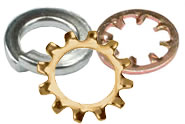
Ever wonder what locking mechanisms engineers use to prevent aerospace fasteners from loosening midflight? Airplanes rely on fasteners to create strong joints and hold various parts together. A typical Boeing 767, in fact, has nearly 2 million fasteners. Even smaller airplanes often have hundreds of thousands of fasteners.
During flight, aerospace fasteners are exposed to strong vibrations. Airflow over the airplane’s fuselage and wings can cause vibrations — particularly during inclement weather conditions. The airplane’s engines also produce strong vibrations. Even the landing gear can produce vibrations as it extends and retracts. Fortunately, airplanes are often designed with locking mechanisms that allow them to withstand vibrations without loosening.
Safety Wire
Safety wire is commonly used to prevent aerospace fasteners from loosening. Also known as lock wire, it’s typically run through a predrilled hole in a fastener and then anchored to an adjacent fastener. The end is then twisted to create tension. This tension helps to resist loosening caused by vibrations or other external forces.
Castellated Nuts and Cotter Pins
Some aerospace fasteners are equipped with a castellated nut and cotter pin to prevent them from loosening. Castellated nuts are characterized by an array of slot-like indentations or castellations. After twisting a castellated nut onto the end of a threaded fastener, a cotter pin is placed through one of these castellations and into a hole drilled into the fastener. The cotter pin will then hold the fastener in place.
Split Lock Washers
Another locking mechanism to prevent aerospace fasteners from loosening is the split lock washer. Like all washers, split lock washers are placed around a threaded fastener. While traditional washers are flat, though, split lock washers are raised. They feature a cutout that results in a split, raised design. When a split lock washer is tightened, the fastener’s head will press against the washer, essentially flattening it while creating spring-like tension.
Lock Nuts
In addition to lock washers, there are lock nuts. Nylon insert lock nuts, for instance, feature a collar with embedded nylon material. This nylon collar is smaller than the diameter of the fastener with which it’s used. When you tighten a nylon insert lock nut, the collar will compress, thereby creating friction and tension that holds the fastener in place.
Thread-Locking Fluid
Thread-locking fluid is commonly used to prevent fasteners from loosening. Thread-locking fluid is a type of liquid adhesive that helps to support and secure fasteners in place. Placing just a small amount of thread-locking fluid under the head of a fastener can protect it from vibrations.



